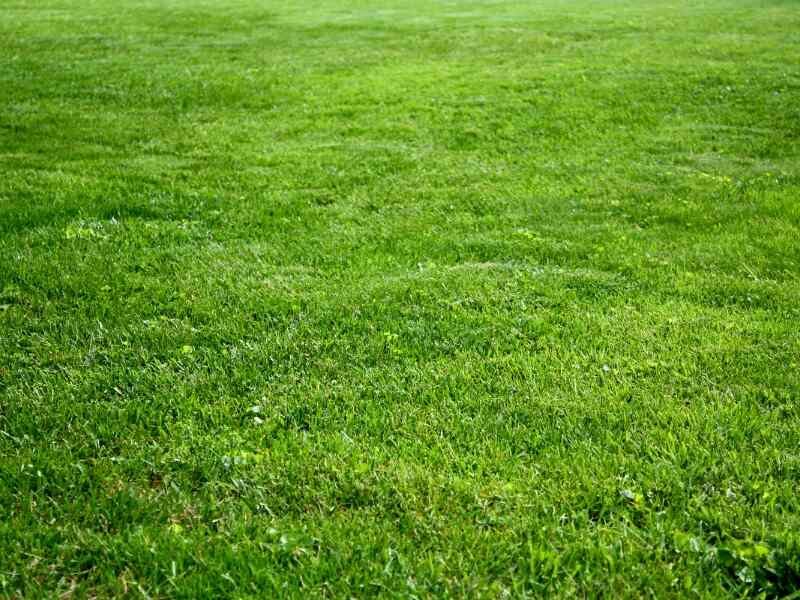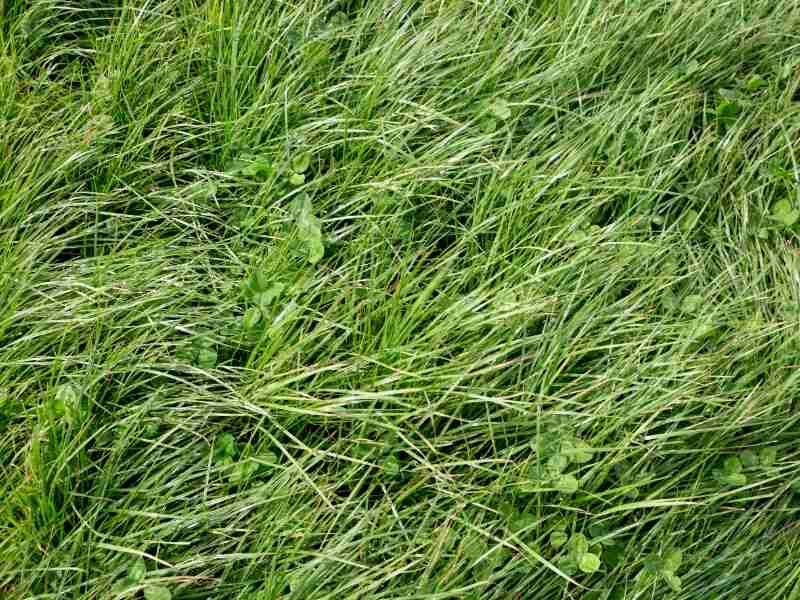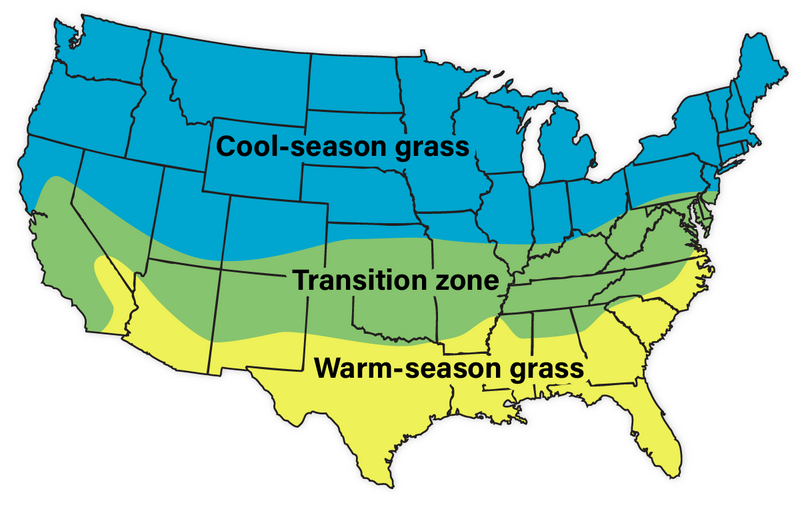
Does your lawn experience heavy foot traffic from active children, playful pets, or regular gatherings? With the wrong type of grass, the constant heavy use can lead to soil compaction, thinning, and damage. Choosing one of the six best grasses for high-traffic areas can help make your lawn withstand heavy foot traffic while maintaining its health and beauty.
So, if your lawn is patchy, brown, and dying due to heavy use, it might be time to shop around for new grass seeds. Here, you’ll learn about their unique strengths and characteristics so you can choose the best grass type for your home lawn.
6 best grasses for high-traffic areas
Maintaining a lush, healthy lawn is a dream for every homeowner, but when it gets a lot of foot traffic, choosing the right grass is paramount. Here are the top high-traffic grass types that perform well in bustling areas:
1. Bermudagrass

Loved for its durability, bermudagrass is commonly used in golf courses and sports fields. Its hardiness comes from its deep roots and quick growth rate. This type of grass can withstand heavy use and quickly recover from damage.
Bermudagrass is a warm-season grass, so it would fare best in warm climates. It boasts excellent heat tolerance and can maintain its vibrant green color even in scorching summer conditions. This grass variety ranges in color from blue-green to gray-green to dark green, but during cold weather, it goes dormant and will dull in color.
Classification: Warm-season grass
Spreads by: Stolons and rhizomes
Shade tolerance: Low – but some bermudagrass cultivars require more direct sun exposure than others
Drought tolerance: High – extended periods of drought may cause it to turn brown and become dormant
Foot traffic tolerance: High – more sensitive when the temperature is low
Maintenance needs: Moderate to high – needs to be fertilized monthly during the summer, and hybrid varieties may need more maintenance
Recommended mowing height: 1-2 inches – during periods of extreme drought or heat, you may have to increase the mowing height to retain moisture
Potential for disease: Moderate resistance – may be susceptible to leaf spot, spring dead spot, brown patch, and dollar spot
Potential for pests: Low resistance – can be prone to hunting billbugs, mole crickets, white grubs, and armyworms
Soil pH: 6-6.5
Soil type: Prefers loam soil but can grow in most types of soil
Other notes: Its growing season is in late spring or early summer
Grass Seed Options:
– Pennington Bermudagrass Bare Spot (5 lb. bag)
– Pennington Smart Seed Bermudagrass Mix (8.75-lb. bag)
– Scotts Turf Builder Bermudagrass (10-lb. bag)
– Hancock Seed Co. Bermudagrass (50-lb. bag)
2. Kentucky bluegrass

A cool-season grass known for its lush, emerald-green appearance and fine texture, Kentucky bluegrass is what most people picture when they imagine the perfect turfgrass. With its soft, smooth texture and blue-green to emerald color, it’s an excellent option if you’re looking to plant grass seeds that produce durable, yet beautiful, grass.
While it’s not as drought-resistant as bermudagrass, Kentucky bluegrass can withstand plenty of foot traffic from active pets and kids. It has a more shallow root system when compared to tall fescue, but its dense turf protects it from foot traffic.
Classification: Cool-season grass
Spreads by: Rhizomes
Shade tolerance: Low to moderate – needs a minimum of four hours of direct sunlight
Drought tolerance: Moderate – goes dormant during extended droughts
Foot traffic tolerance: Moderate to high – but recuperates well
Maintenance needs: Moderate to high – low nutrients can cause delayed growth
Recommended mowing height: 2-3 inches – mow taller during summer
Potential for disease: Moderate to high – mostly prone to fairy rings, snow molds, dollar spot, summer patch, leaf spot, and necrotic ring spot
Potential for pests: Moderate to high – can be susceptible to grubs, sod webworms, chinch bugs, armyworms, greenbugs, and bluegrass billbugs
Soil pH: 6-7
Soil type: Well-drained, fertile soils
Other notes: It’s often included in high-traffic grass seed blends due to its ability to self-repair and establish a dense, thick turf. Also, remember to schedule dethatching at least every other year.
Grass Seed Options:
– Jonathan Green (11970) Blue Panther Kentucky Bluegrass Grass Seed (3 lbs.)
– SeedRanch Midnight Kentucky Bluegrass Seed (5 lbs.)
– Jacklin Seed – Biltmore Blue Blend – 100% Kentucky Bluegrass (5 lbs.)
3. Perennial ryegrass

Perennial ryegrass is so durable that it is a popular grass type for golf courses in northern climates. This fast-growing grass germinates quickly, establishing a robust turf with tough blades and a strong root system.
Often used in overseeding practices for winter color in warm-season grasses, perennial ryegrass has a fine leaf texture and rich green color, making it an appealing choice for lawns, parks, and playgrounds.
Classification: Cool-season grass
Spreads by: Bunch-type
Shade tolerance: Low – needs at least four to five hours under the sun
Drought tolerance: Low – drought will lead to dormancy, but it quickly revives when watered
Foot traffic tolerance: High – but recuperates poorly
Maintenance needs: High – needs frequent watering, mowing, and fertilization
Recommended mowing height: 2-3 inches
Potential for disease: Low resistance – heat and humidity can cause gray leaf spot and other diseases like red thread, flag rust, brown patch, stem rust, and downy mildew
Potential for pests: High resistance – but can be prone to chinch bugs, greenbug aphids, and billbugs
Soil pH: 6-7
Soil type: Grows in most soil types but prefers well-drained, fertile soils
Other notes: Use perennial ryegrass alongside Kentucky bluegrass or other grass seeds to thicken your lawn and repair dead patches. It will not produce as much thatch as other cool-season grass types.
Grass Seed Options:
– Outsidepride Perennial Ryegrass Seed (5 lbs.)
– Eretz ProTurf Perennial Ryegrass Fine Lawn Seed (choose your size)
4. Seashore paspalum

Another warm-season grass variety, seashore paspalum is recognized for its resilience to salt spray and its capacity to flourish in coastal regions. It thrives in salty and sandy environments, making it an excellent choice for properties near the ocean.
With its unique shade of blue-green and fine consistency, it remains a preferred selection for upscale landscapes. In fact, it can preserve its distinctive color and texture even under challenging environmental circumstances.
It thrives in temperature ranges spanning from 75 to 95 degrees Fahrenheit and demands consistent irrigation to sustain its optimal appearance. Despite its saltwater tolerance, seashore paspalum still necessitates well-drained soil and appropriate watering practices.
Classification: Warm-season grass
Spreads by: Stolons
Shade tolerance: Very low
Drought tolerance: Very low
Foot traffic tolerance: High
Maintenance needs: High – needs frequent mowing, watering, and fertilization
Recommended mowing height: 1-2 inches
Potential for disease: High resistance – but it can be susceptible to pythium blight, take-all root rot, and Helminthosporium disease
Potential for pests: High resistance – but may be affected by mole crickets, sod webworms, and fall armyworms
Soil pH: 6-8
Soil type: Prefers well-drained soil but can still thrive in most types of soil
Other notes: Cold weather is not favorable for this grass variety. Overusing fertilizers may result in the accumulation of thatch, impeding the lawn’s access to essential water and nutrients. Additionally, refrain from applying herbicides not formulated for seashore paspalum.
Grass Seed and Sod Options:
– Seed Ranch SeaShore Paspalum Coated Grass Seed – 1 lb.
– Seed World SeaShore Paspalum Grass Seeds (various amounts)
– Other places to purchase seashore paspalum sod
5. Tall fescue

Tall fescue has coarse, sturdy blades and deep roots, making it a great option for high-traffic lawns. Not only is this grass variety durable against high levels of foot traffic, but it’s also adaptable to changing temperatures and water availability. It can thrive in most climates, from the cool northern regions to the warmer transitional zones.
While it has moderate drought resistance, this fescue grass will fare best in northern climates. In the summer, tall fescue can benefit from overseeding with warm-season grass seeds. It has a wide blade and ranges in color from medium to dark green.
Classification: Cool-season grass
Spreads by: Tillers (Bunch forming)
Shade tolerance: Moderate to high
Drought tolerance: Moderate
Foot traffic tolerance: Moderate to high
Maintenance needs: Low to moderate – can grow in soil with low nutrients
Recommended mowing height: 2-4 inches; mow weekly
Potential for disease: Low to moderate – can be prone to leaf spot, brown patch, and seedling disease
Potential for pests: Low to moderate – mostly susceptible to armyworms, cutworms, grubs, and sod webworms
Soil pH: 5.5-6.5
Soil type: Prefers clay soil but grows in most soil types
Other notes: Like fine fescue, it stays green throughout the summer. Also, you won’t have to worry about thatch buildup.
Grass Seed Options:
– Triple-Play Tall Fescue Grass Seed Blend (5000 sq ft)
– Eretz Kentucky 31 K31 Tall Fescue Grass Seed (choose your size)
– Pennington The Rebels Tall Fescue Grass Seed Mix (7 lb.)
6. Zoysiagrass

Zoysiagrass is another durable warm-season grass. This grass type gets its durability from its dense growth pattern that forms a thick, carpet-like turf able to withstand heavy use. It can thrive in a variety of soil types but can be susceptible to diseases.
While it can vary in color and texture, it typically ranges from light to medium green. This grass type grows quickly in warm weather, providing a durable lawn for your spring and summer gatherings.
Classification: Warm-season grass
Spreads by: Rhizomes and stolons
Shade tolerance: Low to moderate – prefers full sun and will thin in large shaded areas
Drought tolerance: High – but you’ll have to give it supplemental watering during extended periods of drought
Foot traffic tolerance: High
Maintenance needs: Low to moderate – you may need to fertilize it frequently with small amounts of fertilizer
Recommended mowing height: Keep between 1-2.5 inches; mow weekly
Potential for disease: Moderate resistance – large patch disease may activate when the soil is between 65 and 75 degrees
Potential for pests: Moderate resistance – common pests include armyworms, chinch bugs, hunting billbugs, mole crickets, sod webworms, grubs, and nematodes
Soil pH: 6-6.5
Soil type: Grows in most soil types but prefers well-drained, loamy soil
Other notes: You must aerate every one or two years to prevent thatch buildup
Grass Plug and Seed Options:
– Zoysia Plugs (50 Large Grass Plugs)
– Zoysia Plugs (50 Full & Lush Grass Plugs)
– Zoysia Plugs (100 Plugs)
– Zoysia Emerald Grass Seeds (1/8 lb. of seeds)
– Zenith Zenith Grass Seeds (1/8 lb. of seeds)
How to tell if foot traffic is hurting your lawn
If your lawn is patchy, brown, and dying, consider the kind of grass you have planted. If the grass type is supposed to be resistant to heavy foot traffic, check if you have thatch buildup and schedule to dethatch or aerate your lawn. And if your grass type is sensitive to foot traffic, consider planting a more durable grass seed.
Additionally, lawns that get heavy foot traffic can be more vulnerable to diseases if not properly maintained. Lawn diseases, especially fungus, appear as yellow, tan, or brown spots of various sizes on the lawn. Dormancy due to weather conditions or infrequent watering also can cause similar symptoms.
Note: You’ll likely be able to tell the difference between foot traffic damage and lawn diseases because most diseases will appear like a perfect ring, while traffic damage will look like sporadic regions of dying or dead grass.
Impacts of heavy foot traffic on your lawn
High-traffic lawns can experience several negative impacts, both visible and hidden, which can compromise its health and aesthetic appeal:
- Soil compaction: When people walk on your lawn, the pressure from their weight compresses the soil particles. Compacted soil becomes dense and hard, reducing the space between particles and hindering root growth and overall grass health.
- Thinning and damage: The constant pressure and friction from footsteps can cause the grass blades to bend, tear, or break. This not only diminishes the lawn’s visual appeal but also weakens the individual grass plants.
- Reduced disease resistance: Grass damage weakens your lawn’s natural defenses, making it easier for pathogens to take hold. Brown patches, fungal infections, and insect infestations may become more common in high-traffic areas.
- Bare patches: These are areas where the grass has been trampled or worn away, leaving the soil exposed. Bare patches are not only unsightly but also prone to weed invasion and soil erosion.
- Weed and moss growth: Weeds and moss can quickly establish themselves in areas where the grass is weakened, further diminishing the lawn’s overall health and appearance.
- Reduced aesthetic appeal: A lawn damaged by heavy foot traffic may lose its lush, vibrant appearance. Instead, you may notice bare spots, uneven growth, and an overall decline in visual appeal.
Note: If you live in the transition zone, you have an extra challenge: You have to deal with brutal summers and freezing winters. Opt for a cool-season grass type with high heat tolerance, such as tall fescue. Or, you can plant a warm-season grass type that can survive cold temperatures, like Zoysiagrass.

How to repair grass damaged by foot traffic
If foot traffic has taken a toll on your lawn, you must know how to revive the damaged areas and restore your grass to its former glory. Do the following to help your lawn recover its health and vitality:
- Assess the damage: Determine whether this is a long-term or quick fix. Do you have one patch you’re concerned about, or is your lawn covered in patches of dead grass?
- Identify frequented areas: Check if your kids can play soccer in another area of the lawn or train your dog to play in the spot near the woods.
- Overseed bare spots: Do this when soil temperatures are around 60 to 80 degrees, typically in late spring or early fall.
- Give it a break: Give your grass time to repair or your new grass seeds time to establish. This can take about a month.
- Water frequently: Plan a time in your calendar to water the lawn a few times a week or so, depending on the grass type. Having a hydrated lawn prevents it from becoming fragile and vulnerable to damage and disease.
How to prevent lawn damage
If you want to preserve your healthy lawn, prevention is often the best defense. Here are proactive measures and strategies to help you keep your lawn resilient:
- Fertilize regularly to keep your grass growing and prevent weeds.
- Aerate annually to reduce soil compaction.
- Mow regularly. For durable grass, mow to the highest recommended height. Mowing your grass too short is one of the most common lawn care mistakes. Scalping your lawn will lead to increased weeds, sun damage, and weakening of the grassroots.
- Allow new grass seeds time to establish a dense root system before allowing kids or pets to play on it.
- Rotate the areas where outdoor activities are being held so that one area isn’t more frequently used than the rest of the yard.
- Keep off the grass when it’s wet and more prone to damage.
- Consider installing pavers, stepping stones, or a similar hardscape material to provide a clear walking path and distribute the pressure of footsteps.
Also, ensure your lawn gets the proper amount of sunlight and water for your grass type.
| Grass type | Sunlight requirements | Watering needs |
| Bermudagrass | Full sun (6-8 hours) | Low to moderate |
| Kentucky bluegrass | Full sun to partial shade (4-6 hours) | Moderate to high |
| Perennial ryegrass | Full sun to partial shade (4-6 hours) | Moderate to high |
| Seaside paspalum | Full sun (6-8 hours) | Moderate to high |
| Tall fescue | Full sun to partial shade (4-6 hours) | Moderate to high |
| Zoysiagrass | Full sun (6-8 hours) | Low to moderate |
FAQ about the best grasses for high-traffic areas
Can I mix different grass types in my high-traffic lawn?
Yes, mixing grass types can enhance the lawn’s resilience. Consult with a local expert or nursery for the best combination for your region.
Is St. Augustinegrass also resistant to heavy foot traffic?
While it can recover from some wear and tear, St. Augustinegrass can only tolerate moderate foot traffic. It’s not as resilient to heavy foot traffic as the other grass varieties listed above. Homeowners who prefer this lawn grass variety must use preventive measures and avoid excessive traffic to maintain its health and appearance.
How often should I aerate my high-traffic lawn?
Aeration frequency depends on your soil type and climate. Typically, once a year is sufficient, but some lawns may benefit from more frequent aeration.
Here’s a quick overview of how often aeration is needed based on soil type:
| Soil type | Aeration frequency |
| Sandy soil | Every two to three years, as needed |
| Loam soil | Once a year, in the fall |
| Clay soil | Once or twice a year |
| Mixed soil (varied) | Assess based on the dominant soil type |
| Compact soil (all) | Twice a year or as needed |
Note: The aeration frequency may differ depending on the unique characteristics of your lawn, the prevailing climate, and other factors. Maintain regular lawn assessments and aerate whenever necessary to safeguard its well-being and robustness.
Protect your lawn from foot traffic
Whether it’s the robust bermudagrass, the elegant Kentucky bluegrass, or other high-quality seed blends, there’s a perfect grass type for your specific needs. With the right grass type, proper care, and preventive measures, you can maintain a beautiful and healthy lawn.Need a hand choosing the best grass seeds for your lawn? Reach out to a local lawn care pro who not only knows the best grasses for high-traffic areas but also can assist with all of your landscaping design and maintenance needs.
Main Photo Credit: Joe Caione | Unsplash